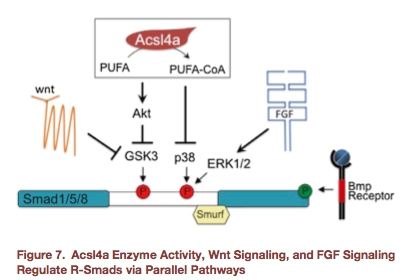April 25 with Bethany Carboneau
Long-chain Acyl-CoA synthetase 4A regulates Smad activity and dorsoventral patterning in the zebrafish embryo.
Presented by Bethany Carboneau, Graduate Student (Maureen Gannon Lab)
Miyares et al. (2013) Developmental Cell 27(6); 635-47.
http://ac.els-cdn.com/S1534580713006746/1-s2.0-S1534580713006746-main.pdf?_tid=df238a8c- c95f-11e3-8967-00000aab0f6c&acdnat=1398090115_3bc52abc7a68698f3b14659a0cd95ce6

One of the first events in embryogenesis is the specification of anteroposterior and dorsoventral embryonic axes. In zebrafish, it is well established that localized BMP activity promotes ventral fates, and several extracellular modulators of BMP are known (e.g., Noggin, Chordin, etc.). MAPK and GSK3 phosphorylation of the BMP-type Smad transcription factors leads to their ubiquitin/proteasome degradation, and is currently hypothesized to be part of the required dorsalizing influence. Miyares et al. report that long-chain polyunsaturated fatty acid acyl-CoA synthetase (Ascl4a) inhibits MAPK/GSK3-mediated Smad phosphorylation, therefore promoting proper dorsoventral patterning. Thus, fatty acid metabolism emerges as a novel regulator of patterning the initial embryonic dorsoventral axis, at least in zebrafish.